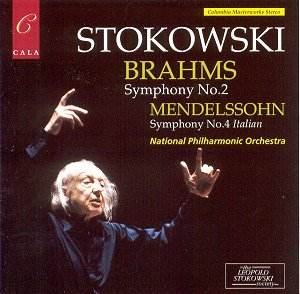Cala is in the process or re-releasing recordings in
association with the Leopold Stokowski Society, made by Leopold Stokowski
throughout his long career. This disc contains two recordings originally
issued on Columbia Masterworks and according to the sleeve are receiving
their first release on CD. Both were recorded in the conductor’s 95th
year, and if memory serves me correctly, was recorded in the same series
of sessions as Bizet’s Symphony, currently available on a two disc compendium
of works by Bizet.
There is an exhilaration in both performances which
is relatively rare in the recording studio. This is not due entirely
to speed, but is within the spirit of the playing. We can put this down
entirely to the skill of the conductor, orchestra and their recording
team. In addition, the phrasing of the playing is long-breathed in the
Beecham manner, so phrases are made to sing and hold together to make
an integrated whole. Both performances have the first movement repeats
which were omitted from much earlier recordings made by the conductor.
Indeed, both recordings are not perhaps what many might
expect from Stokowski – no tampering with the score (as far as I can
tell), just thoroughly good performances recorded in first rate sound.
These make the omission of other Stokowski recordings from the catalogue
even more regrettable. It is to be hoped that Cala will rectify the
deletion strategy of the majors which is even less understandable in
the light of hearing this disc.
The Mendelssohn Italian Symphony starts out with an
allegro vivace which is just that – allegro rather than presto and very
vivace – it really bounces along without making its effect by headlong
speed. Towards the end of the development, we get an impression of real
growth in the musical argument which we can sense through the playing.
If we then add near perfection in the balance of woodwind against strings,
this is obviously an outstanding recording. The second movement, andante
con moto does just that – it moves without becoming bogged down in romantic
stasis. We have more con moto in the third movement, and this movement
in other hands often sounds as though it should be in a much larger
structure. Here, it is light and breathes with life. The last movement,
often taken at a breakneck speed to give the impression of excitement
here is more leisurely but still is clearly a presto. The difference
is that at a slightly slower speed, each of Mendelssohn’s delicate details
in the movement are clearly evident.
The Brahms 2nd Symphony is another of these
minor miracles of interpretation, all the more impressive when we realise
that the conductor was 95 years young. Stokowski seems to have more
life in his little finger than many a younger conductor appears to be
able to muster in his / her whole body.
First movement repeat again for those to whom this
is important, but far more important to my mind is the sense of organic
growth in the playing as Brahm’s miraculous first movement progresses
to its inevitable conclusion. This performance is not one to replace
other illustrious performances such as Abbado, Barbirolli, Karajan and
Walter, but will complement these perfectly. The second movement again
moves beautifully and displays a real sense of growth throughout its
length. When we come to the third movement, allegretto there are clearly
defined paragraphs in the movement, such as at the end of the middle
section, where the lead in to the reprise seems just to do that, a real
paragraph in the structure.
We then move to the finale, which again moves inexorably
to the final brilliant coda without sounding in the least bit rushed
and yet providing real excitement from within.
Throughout, the playing of the National Philharmonic
Orchestra is accurate, musical and full of life. Their playing has been
encapsulated in a recording which is not spectacular at all, merely
very musical, and projecting the interpretation of our veteran conductor
with all the fidelity which one could possibly hope for.
A pair of wonderful performances, beautifully recorded
and presented. More please.
John Phillips



